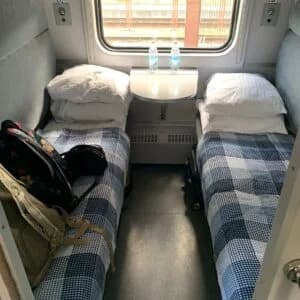How Ukrainians travel abroad during the war
No flights since 24.02.2022
When I visit my family in Italy, people often ask me how my flight from Ukraine went, and they’re surprised when I tell them that all airports have been closed to the public, for obvious reasons, for the past two and a half years.
But how do Ukrainians travel abroad now? First of all, men between the ages of 18 and 60 cannot cross the border without a valid reason—this can range from medical conditions that make someone unfit for military service, to study purposes, or official government missions. The rest of the population is free to enter and leave without major issues.
Since there are no flights, the easiest way to travel—if you don’t have your own car—is by train, which runs from Kyiv to the Polish border town of Przemysl in about ten hours. Besides Przemysl, there are also direct trains to Warsaw, Budapest, and Vienna, but tickets for these routes sell out quickly.
Alternative traveling methods
In addition to trains, there are also buses that travel as far as Italy. This is probably a more convenient option logistically, since they take you directly to your destination, but sitting for more than thirty hours with little space is far from ideal. Online I’ve even seen ads for more spacious buses—though of course much more expensive—costing a few hundred euros.
Besides buses, those with their own vehicle can travel by car. Border checks by car or bus are generally longer than when traveling by train.
Types of train
The Intercity has two classes: first class—with two seats per row—and second class, which has three seats on one side and two on the other. Shortly after departure, a snack cart makes its way down the aisle.
The sleeper train also has two classes. In first class, each compartment is separate and has two beds. In second class, there are four bunk beds per compartment. Each car has its own attendant. When you board, they check your passport, and once the train departs, they come around offering tea or coffee.
Border control
A few kilometers before the Polish border, the train stops and border police come on board to check passports. First there’s a general inspection, then they pass through again to check all male passengers, verifying the official documentation that justifies their travel—something not required for foreigners like me. Finally comes the actual passport control with the stamp. During these checks, dogs are brought through the carriages to sniff the luggage.
Once these steps are finished, it’s often a matter of waiting a few hours on the train while Polish passport control finishes processing the passengers from the previous train. When they give the green light, our train moves forward and crosses the border. In Przemyśl, the Polish passport inspection begins—a slow process, since Ukrainian citizens are not part of the European Union.
When it’s time for checks, the conductors let passengers off one carriage at a time. After the Polish police finish with one carriage, the next group disembarks. Often, some passengers try to outsmart the system by running from one carriage to another to skip the line—and generally, the conductors don’t stop them.
Once through Polish control, we wait for the train to Kraków. The station in Przemyśl is small but has a waiting room for international travelers, a few cafés, and a luggage storage area in case you want to explore the city while waiting for your next train.
From Poland to Italy and back
In Kraków we spend the night in a hotel, and the following day we take a flight to Treviso. The trip takes about two days in total, but compared to traveling entirely by train (which I’ll talk about later), it’s more comfortable since you can relax for a night.
The return journey is similar. From Italy we fly to Kraków, then take the train to Przemyśl, where we wait in line for passport control. The station is small, so the line forms outside. In spring and summer this isn’t much of a problem, but in the harsh Polish winter it can be tough. Mothers with children and pregnant women are allowed through first. After the Polish check, we wait on the train until all passengers are back on board.
The first time we traveled back to Italy after the start of the war, we weren’t familiar with all these procedures and made the journey entirely by train, with two transfers. From Przemyśl we took the train to Vienna, and from there the night train to Pordenone. The total duration was 37 hours, passing through southern Poland, the vast sunflower fields of the Czech Republic, and the mountain landscapes of Austria and northern Friuli.
